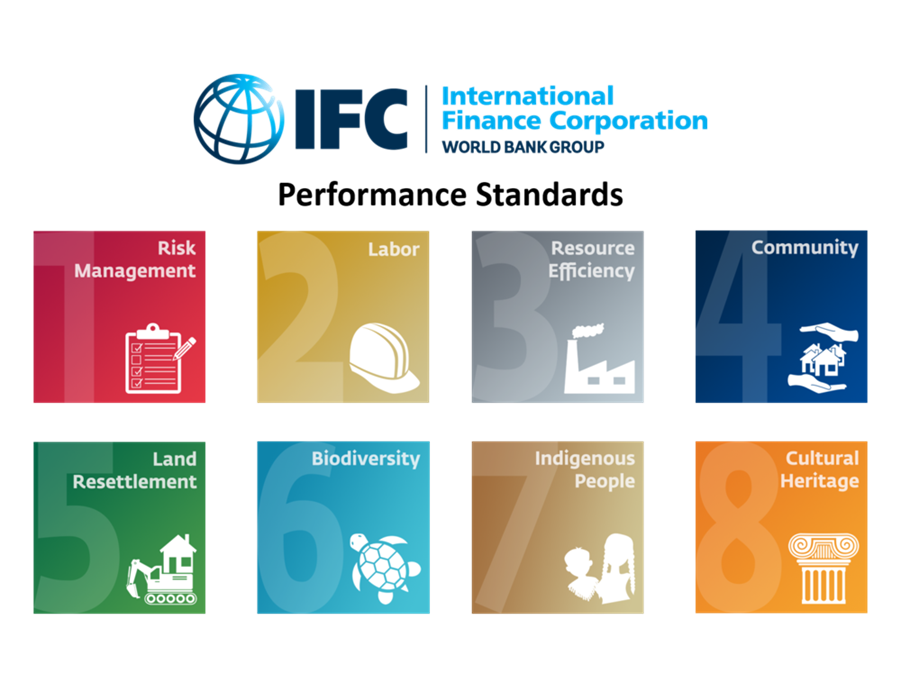
Over the past few years, Nature-based Solutions (NbS) initiatives have drawn both acclaim and criticism on the Voluntary Carbon Market (VCM). If the media celebrate their benefits for both climate, nature, and local communities, concerns are also mounting over the social and environmental integrity of some projects, particularly regarding land rights, equitable benefit-sharing, impacts on communities’ access to resources – when not violence against community members.
These controversies relate to environmental and social (E&S) risks, which are not specific to carbon projects. Infrastructure, mining, and energy sectors have been dealing with them for decades. Across sectors and projects, the challenge is how to better assess the risks and to mitigate them in a commensurate manner.
Within this context, the International Finance Corporation (IFC) Performance Standards (PS) have long served as part of the best international practices for E&S safeguards. Encompassing eight interrelated standards (PS1–PS8), they guide project developers in risk assessment, stakeholder engagement, biodiversity conservation, land acquisition, and labor considerations, among other topics. While traditionally used for IFC-financed projects, their relevance for the VCM is gaining attention as the carbon market matures and E&S expectations increase.
The International Finance Corporation (IFC) is an international financial institution part of the World Bank Group. Its Sustainability Framework articulates IFC’s commitment to sustainable development and is part of its approach to risk management. The Performance Standards are its cornerstone. They are designed to identify, mitigate, manage, and monitor E&S risks throughout any project’s lifecycle.
NbS projects in the carbon market, while sharing the vision and goals to tackle both climate action, biodiversity erosion, and sustainable human development, encompass a diversity of activities, ranging from ecosystem restoration, fight against deforestation, improvement of agricultural practices, and/or tree planting. Behind the diversity of activities, large area management often comes with E&S risks to be addressed. The following section gives an overview of the Performance Standards and how they apply to NbS projects:
Complying with the PS1 requires NbS project developers to run an Environmental and Social Impact Assessment (ESIA) that describes the potential harm project activities could generate to nature and local communities. Risks of negative impacts are quantified and categorized from minor to major. This leads to a risk management plan, describing the strategy to avoid, minimize, and compensate the potential impacts and a description of standardized procedures for the most important risks.
All projects involving land management require workers, whether for planting trees, patrolling in conservation areas, or surveying fauna or flora. Those workers need to be provided with good labor and working conditions, following International Labour Organization (ILO) conventions and national requirements.
Some project activities can rely on natural resources such as water (for nurseries), energy (use of transport), and agricultural inputs. PS3 calls for efficient use of these resources and prevention of air, soil, and water pollution by avoiding practices that could degrade ecosystems (e.g., overuse of fertilizers and water efficiency).
Forestry and conservation-based NbS projects can come at risk for nearby populations, including fire hazards, exposure to wildlife, or conflicts with security personnel (e.g., rangers). It is required of project developers to have proactive mitigation strategies, including emergency response plans, training for community scouts or rangers, and clear codes of conduct for security enforcers.
NbS projects may affect local access to land and resources, specifically when being developed in regions where land tenure is customary. It is paramount to avoid involuntary resettlement, by ensuring continued access to essential ecosystem services, resources, and sacred sites, and providing fair livelihood restoration when impacts are unavoidable. Ongoing stakeholder engagement is crucial to address those topics.
PS6 is central to NbS projects, as biodiversity is often a project’s core asset. It requires baseline biodiversity assessments, including critical habitat identification. Appropriate biodiversity action and monitoring plans are essential, specifically for projects claiming biodiversity co-benefits.
NbS projects might operate on customary lands of Indigenous Peoples. In that case, it is a requirement to implement an FPIC process for any activity likely to affect Indigenous rights or territories. Developers must recognize customary tenure systems, support culturally appropriate benefit-sharing mechanisms, and ensure Indigenous governance structures are included in project decision-making. Documentation of FPIC and ongoing engagement is a requisite.
Project interventions may encounter sacred sites, burial sites, or traditional cultural landscapes. Those need to be mapped, and their access ensured to the communities.

The IFC PS play a role at every stage of project development.
During the design phase, they guide early risk screening and stakeholder engagement (PS1), help ensure clarity of land tenure and use rights (PS5) and promote the avoidance or minimization of negative externalities on communities and ecosystems (PS4 and PS6). These early assessments support better project design and build up the social license of the project.
In the implementation phase, the integration of the IFC PS helps ensure fair labor practices (PS2), robust health and safety protocols, and responsible resource use (PS3). For example, this includes setting clear procedures for contractor oversight, occupational safety in fieldwork, and pollution prevention during project activities.
In the monitoring phase, PS1 provides the foundation for a strong Environmental and Social Management System (ESMS), enabling continuous risk management and adaptive learning. A Stakeholder Engagement Plan (SEP), grievance mechanism, and reporting process, aligned with PS1 requirements, further enhance transparency, accountability, and trust among local stakeholders.
One could argue that carbon crediting frameworks from the VCM are rapidly evolving to address environmental and social (E&S) gaps. In recent years, standards such as the Climate, Community & Biodiversity (CCB) Standards from Verra and the Gold Standard have introduced more stringent E&S requirements for project certification.
However, carbon standards are less stringent and more prone to interpretation than the IFC approach, which brings structured and enforceable risk management protocols. For example, CCB requires compliance with national labor laws, while the IFC PS2 explicitly mandates alignment with ILO core conventions, regardless of national gaps.
Those gaps reflect a fundamental difference in purpose: carbon certification schemes were primarily designed to quantify and verify measurable positive outcomes, such as emission avoidance and removal. Their focus lies in attributing credits to co-benefits rather than ensuring ‘do no harm’ principles across all operational dimensions. In contrast, the IFC PS were developed as a comprehensive due diligence and safeguard framework to ensure that projects not only generate benefits, but also proactively identify, prevent, and mitigate harm to people and ecosystems throughout their lifecycle.
In that sense, the IFC PS offer a valuable grid for E&S screening and procedural rigor, making them a valuable complement for developers of NbS carbon projects seeking to meet both investor expectations and best practice risk management.
Aligning NbS carbon projects with the IFC PS implies a shift from outcome-based validation to process-based risk management combined with rigorous monitoring of both negative and positive impacts. This involves setting up an ESMS and enhancing stakeholder engagement plans and grievance mechanisms with complementary guidelines coming from IFC PS.
Those kinds of measures may increase cost and complexity but will also increase investor confidence and market credibility. This is all the more beneficial in a market increasingly influenced by the Integrity Council for the Voluntary Carbon Market’s Core Carbon Principles. Principle 9 of the ICVCM stipulates that “the carbon-crediting program shall have clear guidance, tools and compliance procedures to ensure mitigation activities conform with or go beyond widely established industry best practices on social and environmental safeguards”. To that regard, IFC PS are a valuable framework to work in.
As the VCM matures, it undergoes a structural shift. Historically, certification systems were focusing on demonstrating additionality and quantifying carbon benefits of carbon projects, with E&S due diligence often being treated as a checklist to meet certification requirements, rather than a comprehensive risk management framework.
Today, carbon projects attract larger institutional investors, who bring with them decades of experience from infrastructure and extractive sectors, project types that are associated with high E&S risks. Those investors might act as early-stage controllers, setting expectations and demanding ESG assurance well before the first credit is issued, making their financing conditional to E&S risk management. In that context of rising compliance expectations, IFC PS offer a useful framework to the VCM to strengthen projects’ E&S risk assessment and mitigation. While this will not end all controversies, having reinforced E&S safeguards might bring back the spotlight on biodiversity and social co-benefits of NbS projects and drive much-needed financing to achieve them.
hummingbirds has been proactively adapting both internal practices and partner engagement strategies with the aim to meet the IFC PS. Internally, we have been working on E&S screening protocols and compliance tools to ensure consistency, traceability, and alignment with international best practices. We bring support and capacity-building to our partners in E&S project management, adapted to the local context. Our ultimate objective is to ensure that environmental and social (E&S) risk management is not just a compliance exercise but a core component of project design, implementation, and monitoring.
